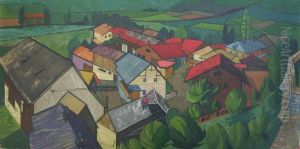Joseph De Decker Paintings
Joseph De Decker was a Belgian sculptor born on February 15, 1853, in Sint-Gillis-bij-Dendermonde. He is best known for his naturalistic sculptures, often inspired by the rural life and traditions of his homeland. De Decker's work reflects a mastery of form and a deep appreciation for the beauty of everyday subjects, ranging from agricultural workers to domestic animals.
In his early life, De Decker received his initial artistic training at the Academy of Fine Arts in Dendermonde. He then furthered his studies at the Royal Academy of Fine Arts in Antwerp, where he was influenced by the prevailing artistic movements of the time and the teachings of leading artists such as Jean Geefs. De Decker's talent was evident early on, and he began to receive commissions and recognition for his work.
Throughout his career, Joseph De Decker exhibited his work widely, participating in salons and exhibitions in Belgium and abroad. His sculptures often depicted the peasantry and the nobility of labor, which resonated with a broad audience, especially during a time when there was a romanticized view of rural life. His work is characterized by its realistic portrayal of his subjects, attention to detail, and the emotional depth he brought to his depictions of everyday scenes.
De Decker's sculptures can be found in various public spaces and museums, which have helped to cement his legacy as one of Belgium's noteworthy sculptors of his time. In addition to standalone sculptures, he also created decorative reliefs and monumental works that have adorned public buildings and spaces.
Joseph De Decker passed away on October 7, 1924. Although perhaps not as widely known as some of his contemporaries, his work remains a significant part of Belgian cultural heritage and continues to be appreciated for its contribution to the naturalist tradition in sculpture.
